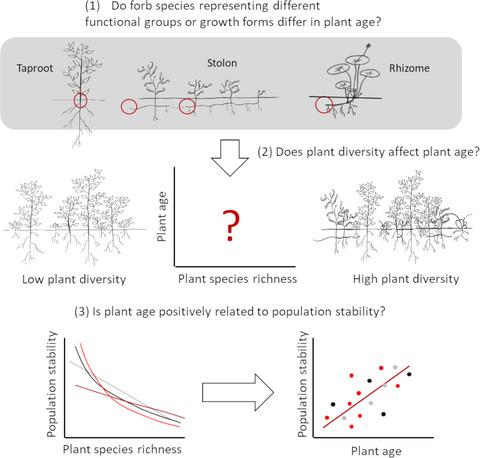Our official English website, www.x-mol.net, welcomes your
feedback! (Note: you will need to create a separate account there.)
Plant diversity effects on plant longevity and their relationships to population stability in experimental grasslands
Journal of Ecology ( IF 5.3 ) Pub Date : 2021-04-02 , DOI: 10.1111/1365-2745.13661 Anna Roeder 1, 2 , Fritz H. Schweingruber 3 , Anne Ebeling 4 , Nico Eisenhauer 2, 5 , Markus Fischer 6 , Christiane Roscher 1, 2
中文翻译:

实验草地植物多样性对植物寿命的影响及其与种群稳定性的关系
更新日期:2021-04-02
Journal of Ecology ( IF 5.3 ) Pub Date : 2021-04-02 , DOI: 10.1111/1365-2745.13661 Anna Roeder 1, 2 , Fritz H. Schweingruber 3 , Anne Ebeling 4 , Nico Eisenhauer 2, 5 , Markus Fischer 6 , Christiane Roscher 1, 2
Affiliation

|
- Identifying to what degree inherent characteristics of plant species and their variation in response to their environment regulate the temporal stability of plant populations is important to understand patterns of species coexistence and the stability of ecosystems. Longevity is a key characteristic of plant life history and an important component of demographic storage, but age is usually unknown for herbaceous species.
- In a 12-year-old biodiversity experiment (Jena Experiment) comprising 80 grassland communities with six levels of plant species richness (1, 2, 4, 8, 16 and 60 species) and four levels of functional groups richness (1, 2, 3 and 4 functional groups), we studied populations of 38 dicotyledonous forb species (N = 1,683 plant individuals). The sampled individuals represented three plant functional groups (legumes, small herbs and tall herbs) and two different growth forms (species with long-lived primary roots and clonal species with rhizomes/stolons). We assessed the age of plant individuals by means of growth ring analysis and related the age of plant populations to their temporal stability in terms of peak biomass production.
- On average, plant species richness did not affect the mean age of the populations or the maximum age of individuals found in a population. Age of herbs with taproots increased and age of herbs with clonal growth decreased with increasing species richness, cancelling out each other when growth forms were analysed together. Mean population age was lowest for small herbs and highest for tall herbs, while legumes had an intermediate population age. Herbs with a taproot were on average older than herbs with a rhizome. Across all species-richness levels, populations with older individuals were more stable in terms of biomass production over time.
- Synthesis. Our study shows for the first time across multiple species that the longevity of forbs is affected by the diversity of the surrounding plant community, and that plant longevity as an important component of demographic storage increases the temporal stability of populations of grassland forb species.
中文翻译:

实验草地植物多样性对植物寿命的影响及其与种群稳定性的关系
- 确定植物物种的固有特征及其对环境响应的变化在多大程度上调节植物种群的时间稳定性,对于了解物种共存模式和生态系统稳定性非常重要。长寿是植物生命史的一个关键特征,也是人口储存的重要组成部分,但草本物种的年龄通常是未知的。
- 在一项为期 12 年的生物多样性实验(耶拿实验)中,包含 80 个草地群落,具有六个植物物种丰富度级别(1、2、4、8、16 和 60 种)和四个功能群丰富度级别(1、2、 3 和 4 个功能组),我们研究了 38 个双子叶植物种群(N = 1,683 个植物个体)。采样个体代表三个植物功能组(豆类、小草本和高大草本)和两种不同的生长形式(具有长寿主根的物种和具有根茎/匍匐茎的克隆物种)。我们通过年轮分析评估了植物个体的年龄,并将植物种群的年龄与它们在生物量峰值生产方面的时间稳定性相关联。
- 平均而言,植物物种丰富度不会影响种群的平均年龄或种群中发现的个体的最大年龄。随着物种丰富度的增加,具有主根的草本植物的年龄增加,而具有克隆生长的草本植物的年龄则随着物种丰富度的增加而减少,当一起分析生长形式时,它们相互抵消。小药草的平均种群年龄最低,高大药草的平均种群年龄最高,而豆科植物的种群年龄中等。具有主根的草药平均比具有根茎的草药更古老。在所有物种丰富度水平上,随着时间的推移,个体年龄较大的种群在生物量生产方面更加稳定。
- 合成。我们的研究首次跨多个物种表明,杂草的寿命受周围植物群落多样性的影响,而植物寿命作为人口储存的重要组成部分增加了草地杂草种群的时间稳定性。











































 京公网安备 11010802027423号
京公网安备 11010802027423号